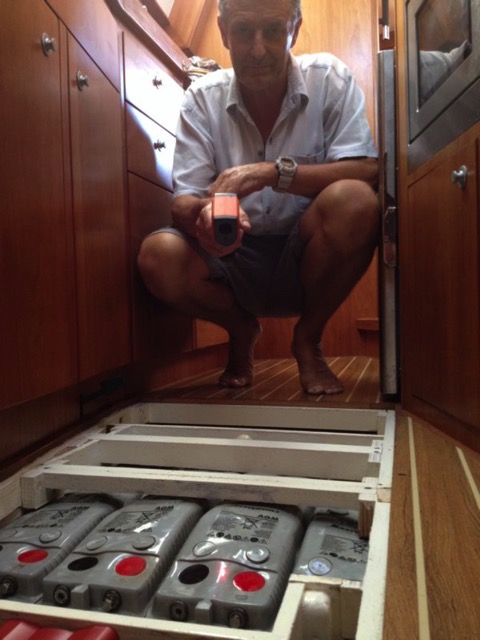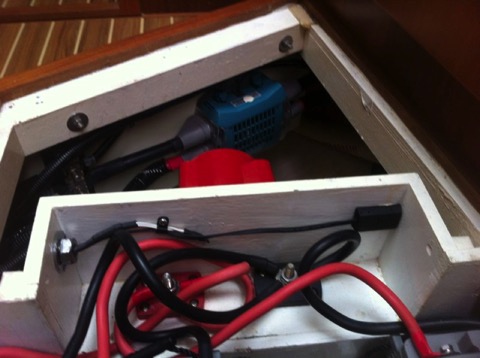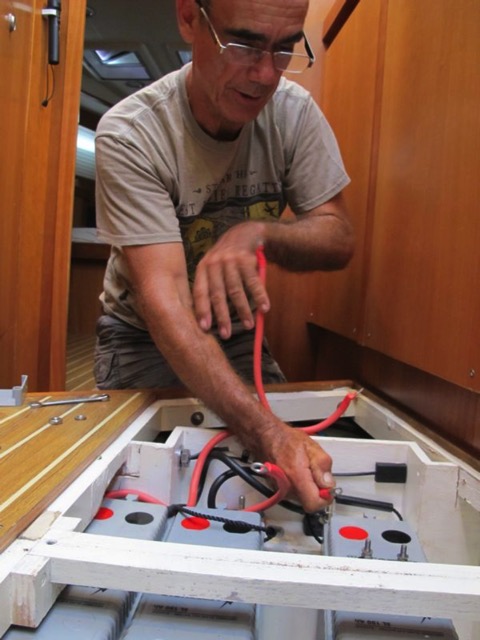Battery Bank Design, Care and Monitoring
03/12/13 07:05 Filed in: Electrical
Boats are meant to be sailed! Leaving a boat stored can lead to problems, and without you there to solve them immediately, the problems can escalate when the boat is unattended. This is what happened to us recently when we came back to the boat and discovered our batteries had had a melt-down...
We left Distant Shores II in the water here in Port Louis Marina in Grenada. It is a lovely marina and we had just planned a short trip home, but ended up staying home for 8 weeks. Normally we will haul the boat out and lay it up for a 2 month period, then the batteries are shut down. In this case we left the boat plugged in and basic systems switched on - bilge pumps, alarm etc. When we came back and opened the boat last Wednesday, the batteries were overheating and the whole compartment was too hot to handle! I estimate it was 100°C. Yikes!
I disconnected the charger, we aired the boat and slept. Clearly the batteries were ruined and we very nearly had a fire on board!
First thing in the morning we called Mike Hulbert our contact at our excellent yacht insurance company - Pantaenius Yacht Insurance in the UK - who passed our info on to claims. Simon Firth was next to be in touch from Pantaenius and had a surveyor over to the boat in just a few hours! Shout out to both Pantaenius and surveyor, Bob Goodchild, for such quick service. Bob did an inspection and measured the temperature of the batteries with a laser heat sensor.

I must say here that I believe the Mastervolt Batteries we have installed on Distant Shores II (and were also on Distant Shores) are the best batteries we have ever had, and are the highest quality AGM batteries available. Electrician, Alan Reynolds, from X-Marine who later came to do an inspection and wire up the batteries as required by the insurance company, also agreed that they were top quality batteries. We have been cruising nearly full time for 4 years, and their capacity appeared to be still as good as they were when we took delivery of Distant Shores II in England in 2010.
The batteries are sealed AGM and obviously hot gases had caused them to expand - but they didn’t crack or burst. Mastervolt make incredibly tough and well engineered products. They have an excellent and well justified reputation in the marine industry.
We must determine what transpired to cause this and are naturally keen to make certain this never happens again. We have looked at the clues and tried to reconstruct a series of events that could explain the problem.
We may never know exactly what occurred to cause this. But one major factor appears to be the battery charger did not shut down the charge even when the whole compartment overheated - reaching nearly 100°C. The charger is supposed to cut current off if the temperature reaches 50°C. Here is the black matchbox size temp sensor installed in the battery box. I emailed Mastervolt technical support with photos. They wrote back directly.

I will buy another sensor and connect it to the charger directly. This will prevent a recurrence of the thermal meltdown we found when we returned. However this does highlight a deeper problem which I think is common to many marine power installations. Our boats have become technically complicated, and if one component fails the resulting cascade of problems can be severe. If we are on board these will likely be caught by the observant boat owner, but if unattended the problems can multiply. My hope is to add a system to monitor the vital stats of the boat when we are away.
The Mastervolt Slimline batteries are an unusual shape - tall and thin, and I was worried we wouldn’t be able to replace them easily. What a surprise to find Island Water World here in Grenada actually had 3 of them in stock - on sale no less!! We bought all three. I will get the fourth at the next St Lucia in a couple of weeks. Although I normally do all the electrical work myself, Pantaenius wanted us to have an electrician check over the whole system. Alan came by (on a Sunday!) to check out the system , connect up the batteries and wrote a comprehensive report.

I am investigating monitoring options to see if there is a way to have a device that would call us if error conditions exist. For instance, if the bilge pump comes on, voltage of the battery goes below 12.5 volts, or above 13.8.
Mastervolt have a GPRS interface for their network that appears it might do what I need. It sends a text message with the info that is available on the power system (volts, amps, temperature etc) but I don’t think it can trigger an alarm if the bilge pump is on.
If anyone has experience with such a device, or experienced a similar problem, please chime in with comments below!
The Story
We left Distant Shores II in the water here in Port Louis Marina in Grenada. It is a lovely marina and we had just planned a short trip home, but ended up staying home for 8 weeks. Normally we will haul the boat out and lay it up for a 2 month period, then the batteries are shut down. In this case we left the boat plugged in and basic systems switched on - bilge pumps, alarm etc. When we came back and opened the boat last Wednesday, the batteries were overheating and the whole compartment was too hot to handle! I estimate it was 100°C. Yikes!
I disconnected the charger, we aired the boat and slept. Clearly the batteries were ruined and we very nearly had a fire on board!
First thing in the morning we called Mike Hulbert our contact at our excellent yacht insurance company - Pantaenius Yacht Insurance in the UK - who passed our info on to claims. Simon Firth was next to be in touch from Pantaenius and had a surveyor over to the boat in just a few hours! Shout out to both Pantaenius and surveyor, Bob Goodchild, for such quick service. Bob did an inspection and measured the temperature of the batteries with a laser heat sensor.

I must say here that I believe the Mastervolt Batteries we have installed on Distant Shores II (and were also on Distant Shores) are the best batteries we have ever had, and are the highest quality AGM batteries available. Electrician, Alan Reynolds, from X-Marine who later came to do an inspection and wire up the batteries as required by the insurance company, also agreed that they were top quality batteries. We have been cruising nearly full time for 4 years, and their capacity appeared to be still as good as they were when we took delivery of Distant Shores II in England in 2010.
The batteries are sealed AGM and obviously hot gases had caused them to expand - but they didn’t crack or burst. Mastervolt make incredibly tough and well engineered products. They have an excellent and well justified reputation in the marine industry.
We must determine what transpired to cause this and are naturally keen to make certain this never happens again. We have looked at the clues and tried to reconstruct a series of events that could explain the problem.
Scenarios
- Perhaps one of the automatic bilge pumps cycled on drawing current consistently...
- If the shore-power breaker somehow tripped off then the battery would be drained over a period of days - flattening the battery. If this continued to draw the battery right down to 0V then one of the cells might be damaged?
- When the power came back on the charger pumped power in but couldn’t charge the batteries due to the bad cell.
- The battery bank might heat up. AGM batteries are somewhat more susceptible to thermal runaway but the excellent Mastervolt Charger is designed to detect the high heat and shut the charger down. It has a sensor to detect battery heat and turn off the charger.
We may never know exactly what occurred to cause this. But one major factor appears to be the battery charger did not shut down the charge even when the whole compartment overheated - reaching nearly 100°C. The charger is supposed to cut current off if the temperature reaches 50°C. Here is the black matchbox size temp sensor installed in the battery box. I emailed Mastervolt technical support with photos. They wrote back directly.

2 Problems
- Mastervolt advise this sensor be directly stuck on the battery - I will move it
- The sensor is wired up to the Shunt Battery monitor instead of connected directly to the Charger. So the charger doesn’t get the info on battery temp.
Solutions
I will buy another sensor and connect it to the charger directly. This will prevent a recurrence of the thermal meltdown we found when we returned. However this does highlight a deeper problem which I think is common to many marine power installations. Our boats have become technically complicated, and if one component fails the resulting cascade of problems can be severe. If we are on board these will likely be caught by the observant boat owner, but if unattended the problems can multiply. My hope is to add a system to monitor the vital stats of the boat when we are away.
New Batteries
The Mastervolt Slimline batteries are an unusual shape - tall and thin, and I was worried we wouldn’t be able to replace them easily. What a surprise to find Island Water World here in Grenada actually had 3 of them in stock - on sale no less!! We bought all three. I will get the fourth at the next St Lucia in a couple of weeks. Although I normally do all the electrical work myself, Pantaenius wanted us to have an electrician check over the whole system. Alan came by (on a Sunday!) to check out the system , connect up the batteries and wrote a comprehensive report.

Recommendations
I am investigating monitoring options to see if there is a way to have a device that would call us if error conditions exist. For instance, if the bilge pump comes on, voltage of the battery goes below 12.5 volts, or above 13.8.
Mastervolt have a GPRS interface for their network that appears it might do what I need. It sends a text message with the info that is available on the power system (volts, amps, temperature etc) but I don’t think it can trigger an alarm if the bilge pump is on.
If anyone has experience with such a device, or experienced a similar problem, please chime in with comments below!
blog comments powered by Disqus